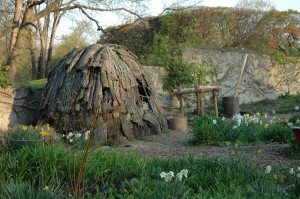Plan Your Weekend: Lenape Wigwam Brings Peace—and Giggles
Posted in Exhibitions, Programs and Events, The Edible Garden on September 4 2009, by Plant Talk
 |
Annie Novak is coordinator of the Children’s Gardening Program in the Ruth Rea Howell Family Garden. Click here to see a Today show segment about the program. |
 A few weeks ago, during one of many rainstorms in the Ruth Rea Howell Family Garden this summer, I took refuge with a few students from our Children’s Gardening Program in the wigwam tucked in the side corner of the garden’s Meadow. While the kids played giddy musical chairs on the stumps inside, I sat quietly with my back against the bark wall. It’s a cozy space. Although the kids were acting loud and giggly, the small wigwam felt peaceful. The rain fell near-noiselessly on the dome of birch saplings. Through the wigwam’s single window, daylilies and tall zebra grass shone orange and green against the gray.
A few weeks ago, during one of many rainstorms in the Ruth Rea Howell Family Garden this summer, I took refuge with a few students from our Children’s Gardening Program in the wigwam tucked in the side corner of the garden’s Meadow. While the kids played giddy musical chairs on the stumps inside, I sat quietly with my back against the bark wall. It’s a cozy space. Although the kids were acting loud and giggly, the small wigwam felt peaceful. The rain fell near-noiselessly on the dome of birch saplings. Through the wigwam’s single window, daylilies and tall zebra grass shone orange and green against the gray.
Part of the Three Sisters display garden, the wigwam was built in 2006 to re-create the lifestyle of the Lenni-Lenape, the first New York natives. When teaching, I often ask my students to imagine what it would be like to live as the Lenape did 400 years ago. I ask the children to think about everything they do inside their homes—cook, read, watch TV, play with toys, take refuge in air conditioning when the summer hits—and think of what the Lenape would be doing instead. With seven-year-olds, of course, a reflective discussion like this leads to hilarity pretty quickly.
But after some groans and giggles about sharing a bedroom with your whole family, comparing lifestyles leads to an epiphany as well. The wigwam only seems small in comparison to today’s houses when you think about it as an equal living environment. But it isn’t. In those early, pre-hustle-and-bustle New York years, an entire world around the home provided the space for cooking, playing, harvesting. (Who needs air conditioning with the Bronx River running so close by?) What I like about the wigwam is its clear definition of necessity. It’s a space of shelter and sleep. Imagination provides the rest.
Of course, the expert in thinking about the world of New York City 400 years ago is Eric Sanderson, Ph.D., author of the acclaimed book Mannahatta and a Garden volunteer. He, his wife Han Yu-Hung who works in the Family Garden, and their son, Everett, as well as many volunteers were instrumental in building the Family Garden’s Three Sisters plot. Before 2005, the Lenape Garden was part of the Global Gardens, at the north end of the Family Garden. The first wigwam was constructed of canvas and plastic hoops, in the area that is now our Korea Garden. (Thankfully, all that exists of the plastic wigwam now is a faded photograph—a relic of the pre-digital age—now push-pinned to our bulletin board.) The current Three Sisters site, on the other hand, was—as Family Garden Manager Toby Adams puts it—“a plant collection of odds and ends.” For example, school instructor Ann Creaney planted a portion of it with potatoes.
Of the new Lenape Garden, Toby says, “It’s turned into a must-visit destination within the Family Garden. Now that it’s located in the Meadow, there’s more space for its many features.” What began as a simple garden plot (corn, squash, and beans defining the “Three Sisters” name) has since become a real world unto itself. In addition to the garden and wigwam, in the spring of this year Bronx Borough President Ruben Diaz, Jr., came with great ceremony to plant blueberry and cranberry bushes in companion to a large, established wall of thorny raspberries and other native edibles such as sunchokes and sunflowers that the Lenape had foraged for.
In a speech before the planting, Diaz eloquently spoke of the importance of children connecting to a nutritious lifestyle through learning how to garden and enjoy the outdoors. It’s a theme that resonates with me deeply and sits at the core of the Family Garden’s mission as a public space inside the Bronx. Which is why, to me, even the tight squeeze inside the wigwam feels peaceful. Because here I am, watching what kids do best: use their imaginations, laugh, and play.
Lenape Life in the Family Garden runs from September 1 through September 27, 1:30–5:30 p.m. Tuesdays–Sundays (and Labor Day!). Visitors are invited to visit the Lenape Garden and sit in the wigwam, shuck and grind corn, make corn husk dolls to take home, and taste freshly popped corn.

